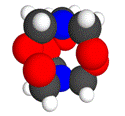Department of Chemistry
Date of this Version
June 1999
Abstract
Methodology for the assignment of 13C CPMAS spectra is still in its infancy. Previous methods of CPMAS spectral editing have utilized differences in the strength of the 13C–1H dipolar interaction or the rate and spin thermodynamics of crosspolarization from protons to carbon, to differentiate between quaternary, tertiary, and methylene carbons. We introduce a different approach, which is based on the fact that double-quantum coherence develops between the protons of a methylene group considerably faster than between most other proton spin pairs in an organic solid. We generate this coherence, filter it, convert it back to single quantum, and then crosspolarize selectively to carbon, followed by a short period of reversed crosspolarization to null out unwanted coherence generated from longer distance spin pairs. The sequence has been named DQCP. While the signal-to-noise of this method is poorer than ordinary CP, it is comparable to previous methods for generating methylene-only spectra, and the technique is straightforward and easy to implement.


Comments
Published in Journal of Magnetic Resonance 141 (1999), pp. 159–163 (1999). Copyright © 1999 by Academic Press. Used by permission. Available online at http://www.idealibrary.com